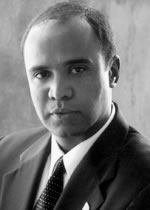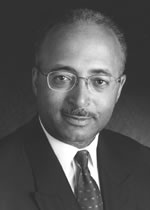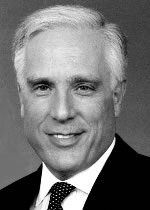Annual Report 2003
Page 2
The building of New York City is a continual process; moving constantly forward through good economic times and bad. The key to maintaining the City’s prominence is to focus on the future, despite the challenges of the present.
The natural temptation during times of recession and budget deficits is to focus narrowly on the most pressing needs while deferring long-range planning and investment until finances improve. Such was the strategy during the fiscal crisis of the 1970s and it is now well known how much the City suffered for that approach.
The New York Building Congress asked prominent local officials – the very people entrusted with framing a vision for the future – to discuss those steps that can be taken now to ensure the City realizes its fullest potential once the economy rebounds and in the decades to follow.
Daniel L. Doctoroff Deputy Mayor for Economic Development and Rebuilding
 These are tough economic times, but we should not and cannot use the current budgetary climate as an excuse for inaction. During similar periods in the City's history, when people thought we couldn't do great things, New Yorkers have summoned the will and found a way to move great projects forward. In fact, the exact time we should be investing in tomorrow is when we fear the future most.
These are tough economic times, but we should not and cannot use the current budgetary climate as an excuse for inaction. During similar periods in the City's history, when people thought we couldn't do great things, New Yorkers have summoned the will and found a way to move great projects forward. In fact, the exact time we should be investing in tomorrow is when we fear the future most.
There is no better example of this than the effort now underway to transform a three million square foot, undeveloped eyesore on Manhattan’s far West Side into a vibrant mixed use community. We have an opportunity to extend Midtown to the edge of the Hudson River and create acres of new parkland, millions of square feet of new office space, and thousands of new jobs. This is an enormous project, but we can look to Park Avenue for inspiration. Park Avenue was a dingy rail yard in 1903, until the City determined to build a platform over the rail yards and create a sprawling, tree-lined boulevard. While the undertaking was massive and initially expensive, it helped to spawn the world's single biggest business district and has paid for itself many times over.
Gifford E. Miller New York City Council Speaker
 Despite facing budget deficits unseen since the 1970s, the future for New York City remains as bright as ever. To help ensure that the promise of the future becomes reality, City officials must make every effort to bridge our budget gap now, rather than mortgage our future through additional borrowing and funding gimmicks. While balancing the budget will require further cuts that will affect all New Yorkers, it will also require the willingness of New York State and Federal legislators to return a fair share of the revenues they raise from City residents.
Despite facing budget deficits unseen since the 1970s, the future for New York City remains as bright as ever. To help ensure that the promise of the future becomes reality, City officials must make every effort to bridge our budget gap now, rather than mortgage our future through additional borrowing and funding gimmicks. While balancing the budget will require further cuts that will affect all New Yorkers, it will also require the willingness of New York State and Federal legislators to return a fair share of the revenues they raise from City residents.
New York City must demand that the State legislature reinstate the commuter tax, which has cost the City $1.5 billion since its repeal, and push for Federal disaster aid to recoup the more than $3 billion in revenue the City lost as a direct result of the September 11 attacks. Also, New York’s leadership should push for a Federal revenue-sharing program, in which Washington would distribute money among localities as a means of balancing budgets and decreasing property taxes. When taken together, these actions would help solve our current budget problems without enacting devastating service cuts or mortgaging our children’s future.
Adolfo Carrión, Jr. Bronx Borough President
 During tough economic times, the City must ensure that public investment is leveraged with private dollars to ensure maximum impact to the community. There is at present little doubt that the New York Yankees will, in partnership with the City, initiate construction of a new or rebuilt stadium in the coming years. In order to have lasting impact, any stadium project must be accompanied by additional investments that address the community’s most pressing needs. Such improvements would include: a hotel and convention center; an expanded ferry landing on the Harlem River waterfront; a new Metro North train station; a Yankee Hall of Fame and Museum; and most importantly, a Bronx High School for Sports Medicine and Sports Industry Careers.
During tough economic times, the City must ensure that public investment is leveraged with private dollars to ensure maximum impact to the community. There is at present little doubt that the New York Yankees will, in partnership with the City, initiate construction of a new or rebuilt stadium in the coming years. In order to have lasting impact, any stadium project must be accompanied by additional investments that address the community’s most pressing needs. Such improvements would include: a hotel and convention center; an expanded ferry landing on the Harlem River waterfront; a new Metro North train station; a Yankee Hall of Fame and Museum; and most importantly, a Bronx High School for Sports Medicine and Sports Industry Careers.
It also is important to finally develop the Bronx Terminal Market, which would transform the Yankee Stadium area into a year-round venue for commercial, recreational and educational activity. It also would open up our waterfront and help transform it from a 19th Century relic into a 21st Century public amenity.
Amanda M. Burden Chair, New York City Planning Commission
 In these challenging times we must think and work in new ways, fostering ideas, nurturing creativity and quickly producing solutions. We must do business in the focused, decisive manner of our Mayor, Michael Bloomberg. Our goal is to get things built that people will point to with pride and appreciation. We have the tools, the talent and the determination.
In these challenging times we must think and work in new ways, fostering ideas, nurturing creativity and quickly producing solutions. We must do business in the focused, decisive manner of our Mayor, Michael Bloomberg. Our goal is to get things built that people will point to with pride and appreciation. We have the tools, the talent and the determination.
This is an exceptional moment for the Department of City Planning. We have an ambitious agenda which demonstrates that New York City is moving forward on solid footing, and that its future, like its past, is extraordinary. Lower Manhattan is a primary concern, and the resources of the Department and Commission will help to provide the framework for its revitalization. Our geographic focus, however, is citywide, and we are also actively working toward a dynamic future for areas such as Long Island City, Jamaica, Hudson Yards, Upper Manhattan, Downtown Brooklyn, the Hub in the Bronx and St. George on Staten Island.
In order to maximize the economic value of new development, we must pay special attention to how buildings meet the street and how they relate to the surrounding neighborhood. While an active streetlife is a constant objective, we are also working diligently to achieve a blend of commerce, culture, recreational opportunities and residential living wherever possible. These paradigms define the Bloomberg Administration’s comprehensive approach to rezoning, planning, and project approval in the five boroughs.
William C. Thompson Jr. New York City Comptroller
 During one of the most economically difficult periods in New York City’s history, we must ensure that our fiscal recovery is both swift and sound. We must avoid repeating the mistakes of the past and resist the temptation to “borrow” our way to a balanced budget. Moving forward, we would be wise to utilize “pay-as-you-go” financing and identify dedicated sources of funding for critical capital projects. We must also be careful not to defer routine maintenance of our infrastructure. When we invest in the proper maintenance of our facilities, we are investing in our future.
During one of the most economically difficult periods in New York City’s history, we must ensure that our fiscal recovery is both swift and sound. We must avoid repeating the mistakes of the past and resist the temptation to “borrow” our way to a balanced budget. Moving forward, we would be wise to utilize “pay-as-you-go” financing and identify dedicated sources of funding for critical capital projects. We must also be careful not to defer routine maintenance of our infrastructure. When we invest in the proper maintenance of our facilities, we are investing in our future.
The City will benefit greatly in the short- and long-term if we continue to bring revenues and expenditures into better alignment and identify additional ways to reduce waste, cut costs, and increase recurring revenues. This will allow us to address future, projected shortfalls while balancing the budget for the current fiscal year. These actions, combined with increased State and Federal support, will help us weather these turbulent times without damaging our future prosperity. By working together, we will build a New York that is stronger than ever.
Peter S. Kalikow Chairman, Metropolitan Transportation Authority
 A key to sustainable, long-term economic growth is the availability of a reliable, affordable and efficient public transportation system, and the New York region is – for the first time in decades – poised to build a number of system expansions and upgrade projects. With $4.5 billion in federal funds earmarked for a multimodal transportation hub and other improvements in Lower Manhattan, we are moving ahead with efforts to create a truly 21st Century transportation infrastructure serving all who come to Lower Manhattan to live, work and visit.
A key to sustainable, long-term economic growth is the availability of a reliable, affordable and efficient public transportation system, and the New York region is – for the first time in decades – poised to build a number of system expansions and upgrade projects. With $4.5 billion in federal funds earmarked for a multimodal transportation hub and other improvements in Lower Manhattan, we are moving ahead with efforts to create a truly 21st Century transportation infrastructure serving all who come to Lower Manhattan to live, work and visit.
Construction of East Side Access for the Long Island Rail Road is also moving forward, and we are in the initial stages of engineering the Second Avenue Subway, as well as an extension of the number 7 line to Manhattan’s far West Side and improvements to airport access. Given myriad potential improvements and the limits on capital funding, the challenge now is to come to consensus on a range of projects that will provide maximum benefit to residents and businesses. Also vital is the formation of a coalition of government, business and labor leaders to lobby for the region's fair share of federal transportation dollars.



